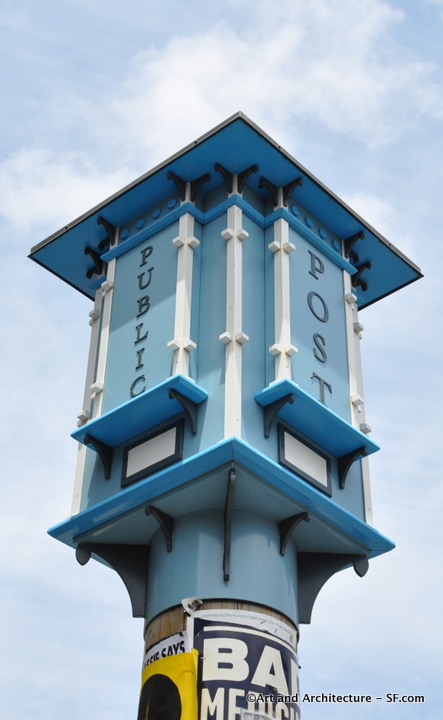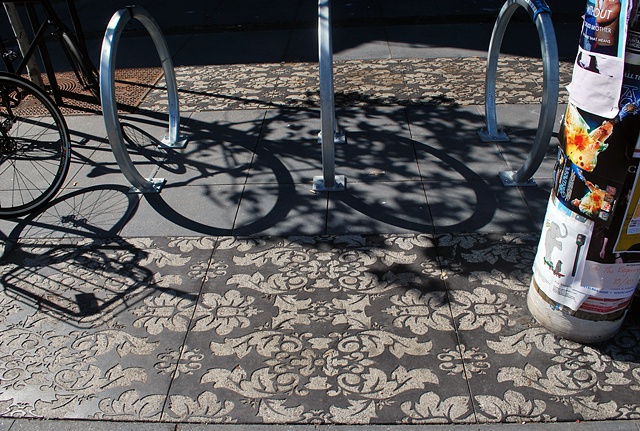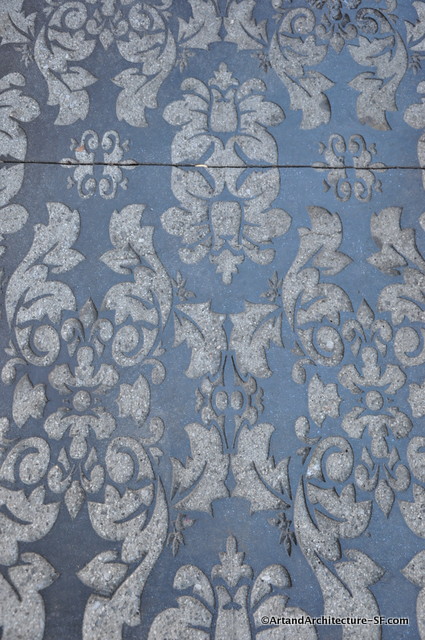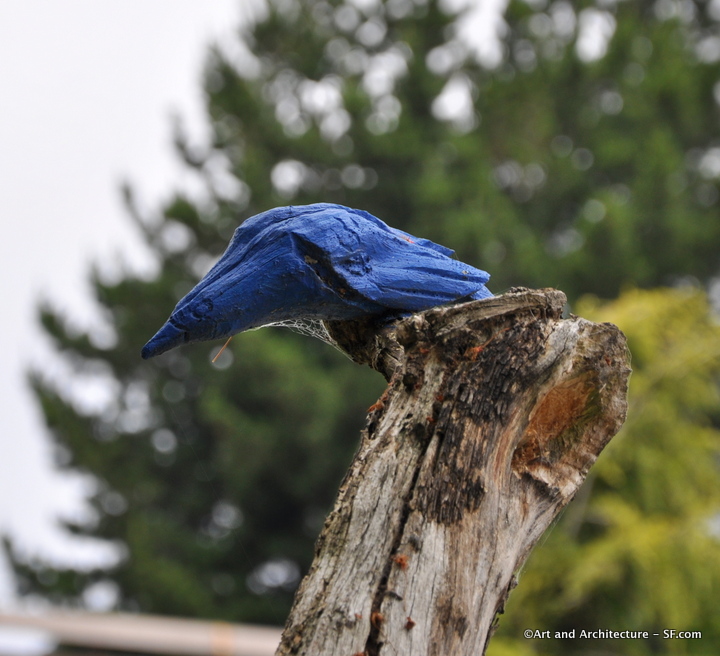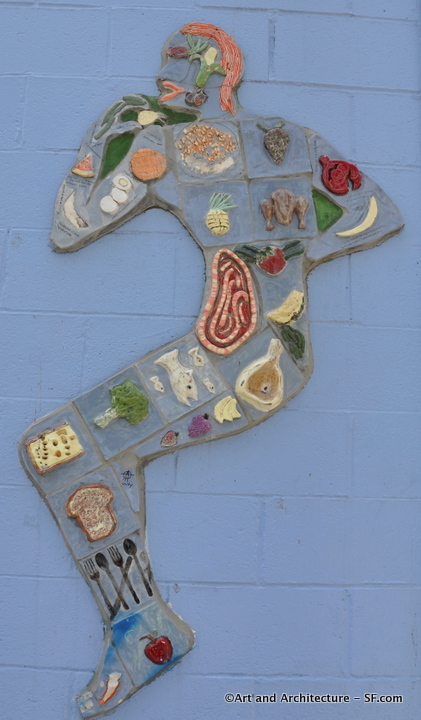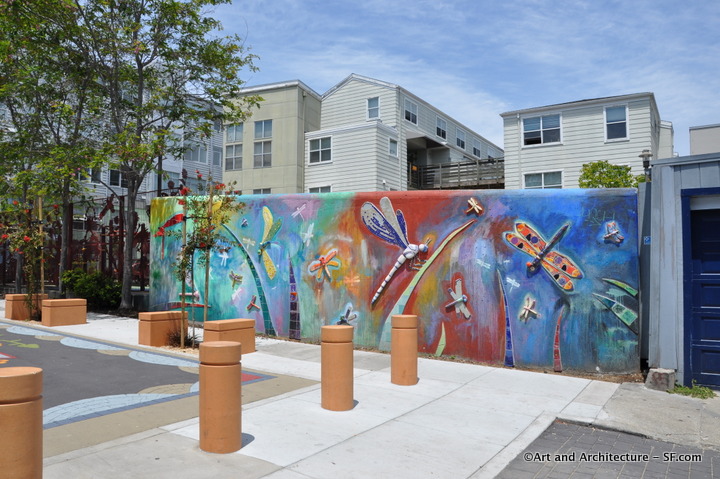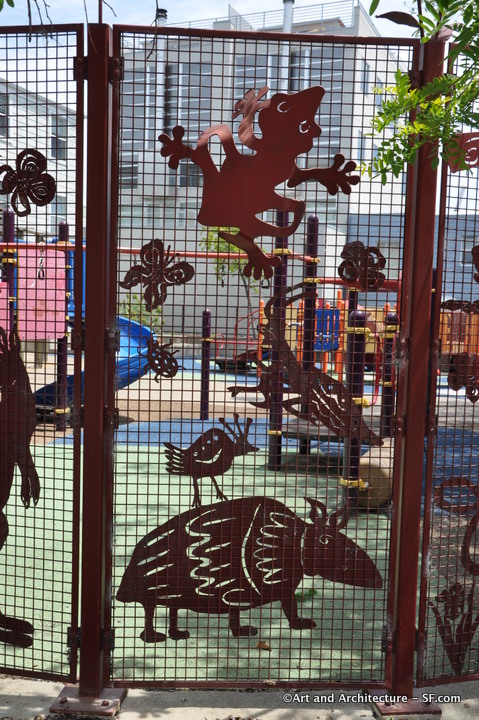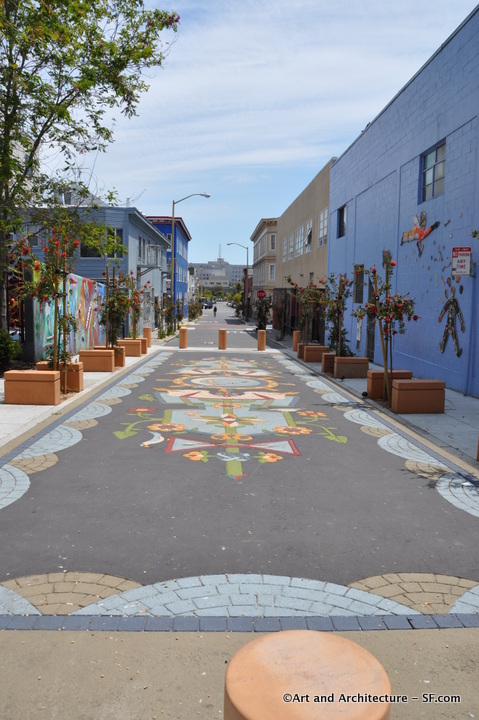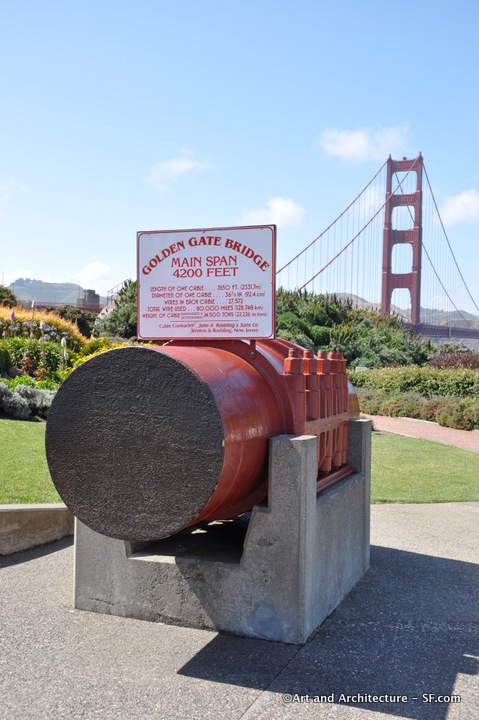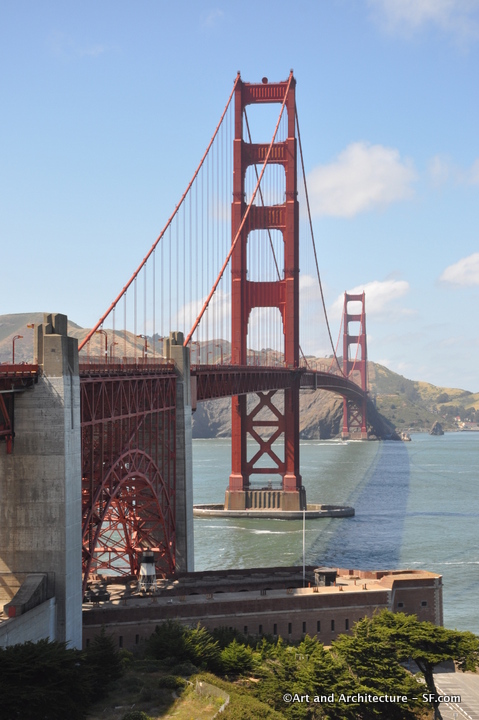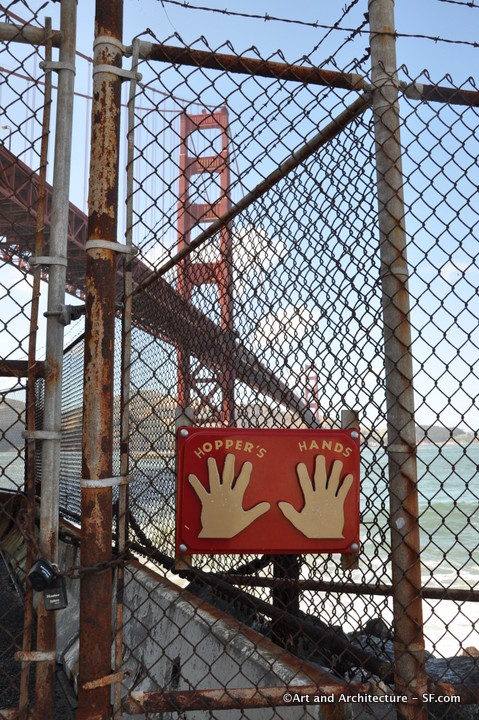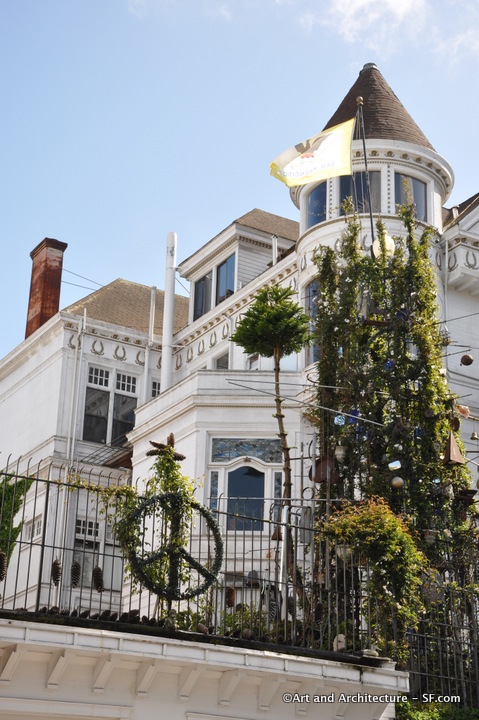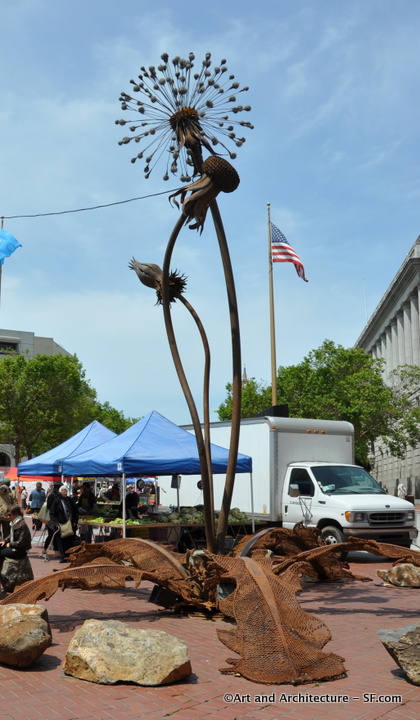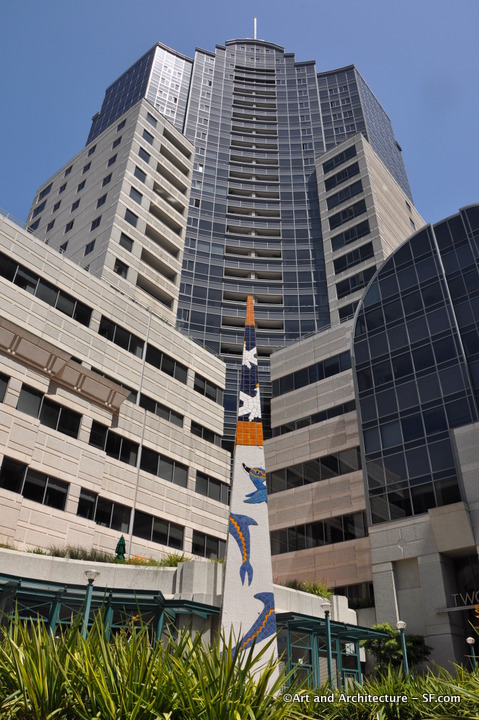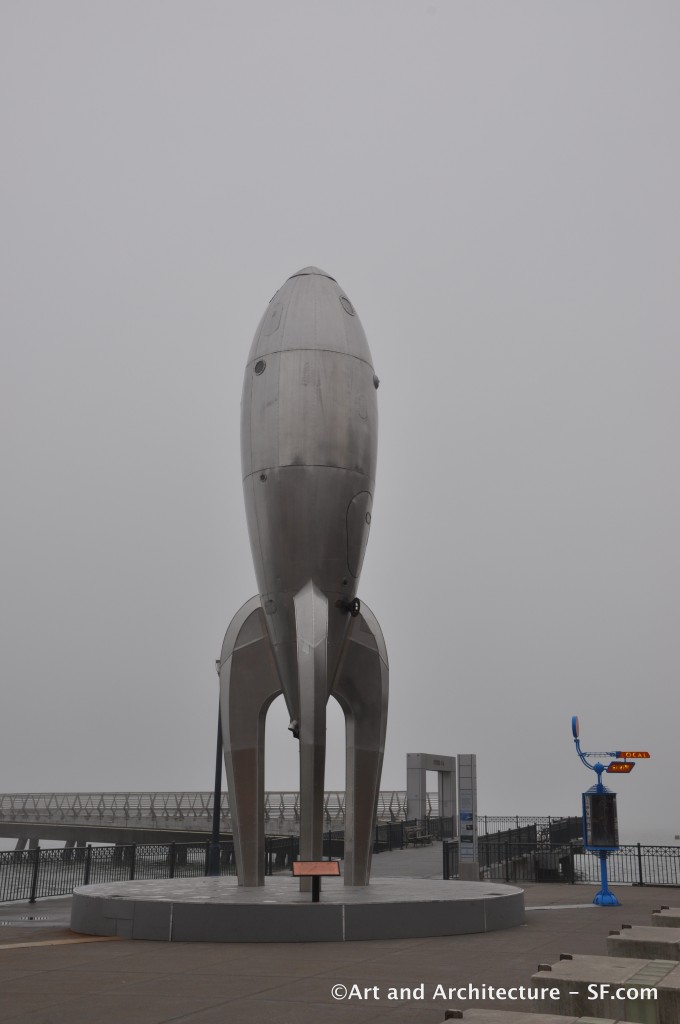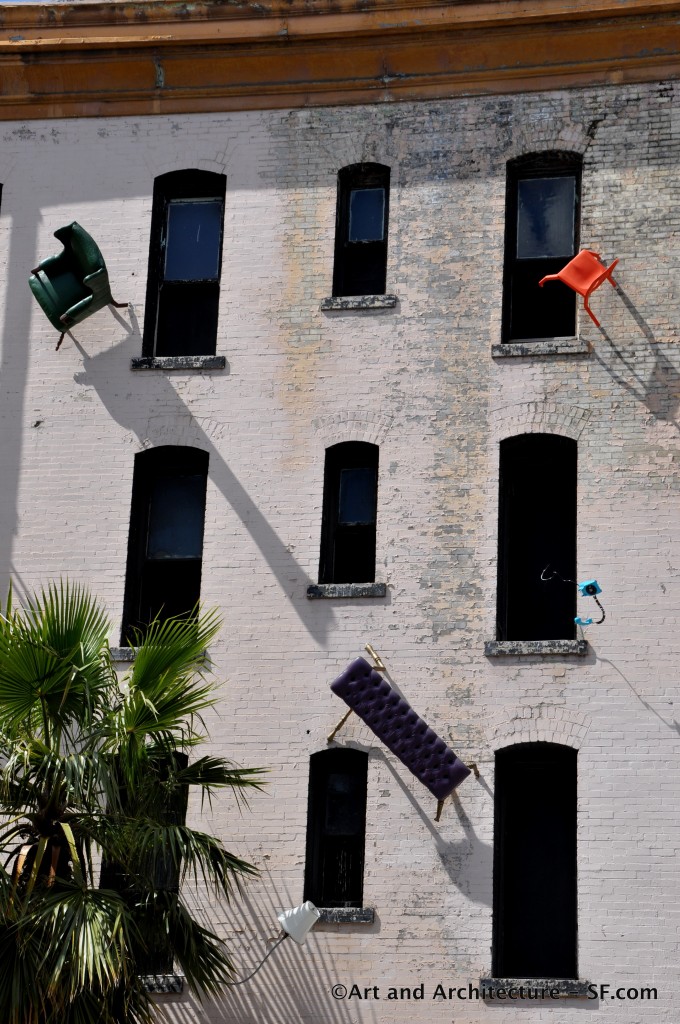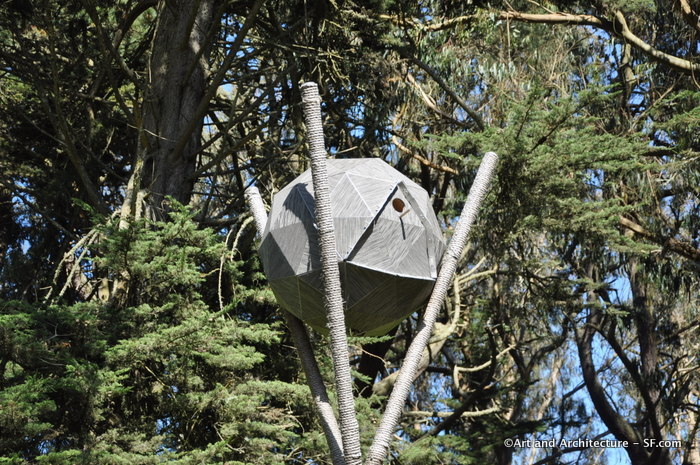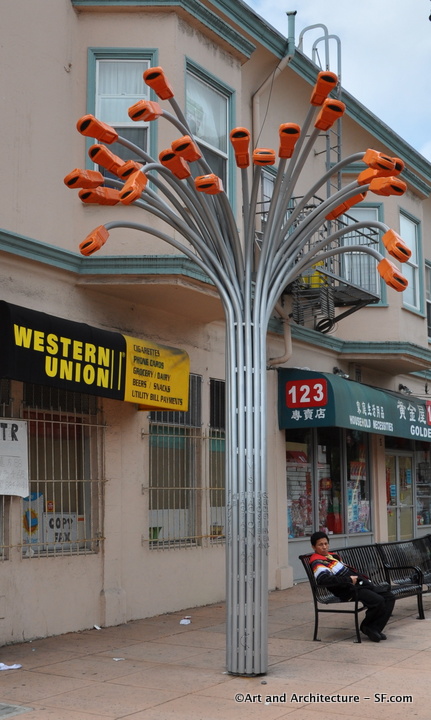 “Sprouting” from the sidewalk like stalks of organically grown street furniture, Street Life is a large-scale sculpture composed of surplus parking meter heads, painted dark orange, attached to tall, arcing steel poles. The sculpture marks the gateway to the entrance of what locals refer to as “downtown” Visitacion Valley.
“Sprouting” from the sidewalk like stalks of organically grown street furniture, Street Life is a large-scale sculpture composed of surplus parking meter heads, painted dark orange, attached to tall, arcing steel poles. The sculpture marks the gateway to the entrance of what locals refer to as “downtown” Visitacion Valley.
Crafted out of steel and aluminum and painted with a durable urethane alkyd enamel, the ornamental crowns are sort of Victorian architecture that is intended to recall the neighborhood’s past history. The Department of Public Works added a decorative paving design based on Victorian wallpaper to the sidewalk surrounding the poles. These are meant to be community bulletin boards, and believe me, they are covered with postings. It is nice to have the city admit that phone polls like this are coated everyday with notices, why not produce something artistic and functional.
Michael received his BFA at the San Francisco Art Institute and his MFA at Stanford University. He is currently a Visiting Faculty at Virginia Commonwealth University.
You can see by the photos that they are in a very vibrant part of town and fit perfectly with their surroundings.
According to Michael’s website he is is an interdisciplinary artist working primarily in sculpture and installation. Though visual, his art revolves largely around language. Directly informed by Historic events, material significance, and the format of jokes, his subject matter deals with sociopolitical circumstances where power relations are unbalanced.As a naturalized American, there is a geographic dimension to Michael’s investigation of cultural markers. These markers are embedded in objects, food, architecture, visual lexicons, and vernacular languages. For instance, vernacular Tagalog, is infused with Spanish and English words, lending itself to verbal mutation. This malleability result in wordplay and jokes that transform words like Persuading to First wedding, Tenacious to Tennis Shoes, Devastation to The Bus Station, and Masturbation to Mass Starvation. His practice draws from the sensibility of both insider and outsider- subtly jumbling signifier, material, linguistics, and site.
Michael was born in Manila, Philippines, and migrated to the Los Angeles area at ten years of age. He relocated to San Francisco to attend the San Francisco Art Institute where he received a BFA. And later, he attended Stanford University for his MFA. He currently lives and works in San Francisco, California.
The decorative sidewalks
This project was funded by the San Francisco Art Commission for $52,000.
This little area has become a hub for the Filipino Community in the San Francisco area. Tutubi means dragonfly in Tagalog. This mural is by Johanna Poethig.. Johanna was born in the Philippines, so I am sure this was especially important to her. She received her BFA from UC Santa Cruz and her MFA from Mills, she presently is an arts educator at Cal State U in Monterey. She has an amazing array of public work that you can see at her website. Many of them are in San Francisco.
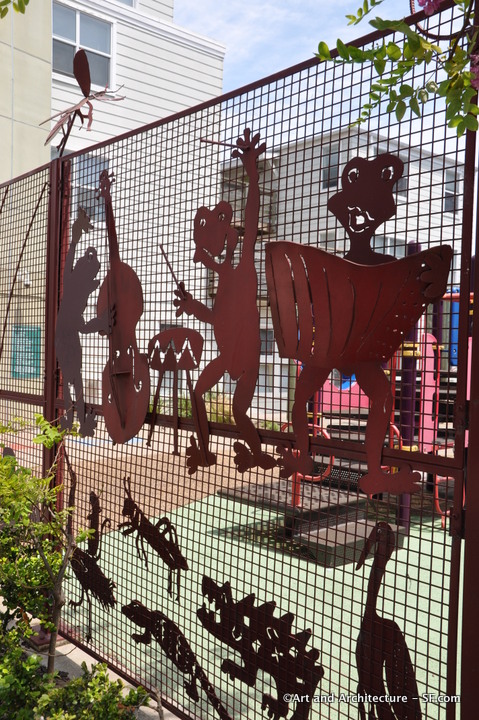 Behind this wall is a children’s park. The fence that surrounds it is also part of the Redevelopment project. The fence surrounding it is by Amy Blackstone.
Behind this wall is a children’s park. The fence that surrounds it is also part of the Redevelopment project. The fence surrounding it is by Amy Blackstone.
It is put down through a process called street print, which is a thermoplastic surfacing system. Apparently they first reheat the asphalt pavement then imprint the asphalt pavement with a template made from 3/8” flexible wire rope. The patterns are then hand painted with a high grade polyurethane compound. That I would have enjoyed watching.
This piece was commissioned by the SFAC for a price not to exceed $15,000.
2018 Update
The street furniture and bollards have been removed and the street is no longer a pedestrian street. The damage is quite obvious.
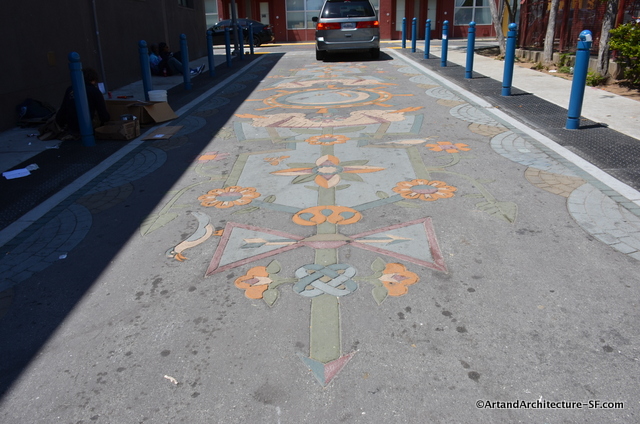
Learn more, watch our video
Golden Gate Bridge Plaza
San Francisco Side
This is a piece of the cable that holds up the Golden Gate Bridge. I have loved this piece since I first laid eyes on it. The sign tells you that the length of one cable is 7640 feet, the diameter is 36 3/8 inches, there are 27, 572 wires in each cable (which is what you are looking at in the end there) they used 80,000 MILES of wire, and the weight of the cable is 24, 700 tons. I think the fact that you are looking at the ends of 27,572 wires is what captured my imagination when I first saw it. This little park is on the San Francisco side of the Golden Gate bridge and provides parking if you want to walk out onto the bridge. On weekends it has large crowds and is nearly impossible to enjoy, but during the week, you can stroll the gardens look out over the city and walk across the bridge at your leisure.
The building at the bottom of this picture is Fort Point. Many people look down upon this structure when they walk across the Golden Gate Bridge, but they never go to visit, which is a shame. Fort Point was completed just before the American civil war. Its purpose was to protect San Francisco harbor from Confederate and foreign attack during and after the U.S. Civil War. The U.S. Army Corps of Engineers began work on Fort Point in 1853. Plans specified that the lowest tier of artillery be as close as possible to water level so cannonballs could ricochet across the water’s surface to hit enemy ships at the water-line. The 90-foot cliff was blasted down to 15 feet above sea level. While manned throughout the Civil War, it never saw an enemy. Its beautifully arched casements display the art of the master brick mason from the Civil War period. The fort is only open on weekends, but to wander the insides and marvel at the arched casements is so very much worth a visit. It is also a wonderful area to just sit and marvel at the beauty of the bay.
For more information on Fort Point please read my article in Untapped Cities.
These are Hopper’s Hands. This plaque is at Fort Point, under the Golden Gate Bridge on the San Francisco side. The area is a turn around spot for people running the Presidio area, and slapping the hands is a tradition. Hopper’s hands has a great story, that I am sure most runners aren’t even aware of.
Ken Hopper is an Iron Worker on the Golden Gate Bridge. Iron workers often agree to train in suicide prevention and rescue on the bridge. Ken is one of those guys. He is one of the many unsung heroes of the city, and this is a great way to get to know him. Scott Ostler wrote a beautiful piece about Hopper in the Chronicle, that has since been taken off of their website so I am including it here, I warn you, you will shed a tear.
SAVING LIVES JUST PART OF THE JOB – Scott Ostler, San Francisco Chronicle, January 10, 2001
“If you’re an ironworker on the Golden Gate Bridge and your home phone rings at 3 a.m., you know it’s trouble.
You know someone is threatening to jump off your bridge. Your stuff is always ready; you’re out the door in minutes.
If you aren’t too late, if you climb out onto the cold steel and sweet-talk some poor lost soul off the beam or tower or manage to wrestle him or her to safety, it’s a good feeling. Many suicide attempts are impulsive; lives can be salvaged.
If you fail, if the person jumps into that bottomless fog, it ruins your day.
“There’s no describing how helpless you feel,” says Ken Hopper, a Golden Gate Bridge ironworker for 17 years.
These ironworkers are tough guys. Men of Steel, they’re called. Cowboys in the Sky. They fix and maintain the world’s most amazing Tinkertoy.
But what qualifies these blue-collar rivet-wrestlers to perform the delicate psychological task of suicide prevention? Just this: There’s nobody else.
“We’re the only ones dumb enough to do it,” Hopper says.
They’re the only ones with enough equipment, knowledge of the bridge and courage to go over the rail.
The suicide rescue duty is voluntary, but the bridge’s ironworkers all take their turns. There’s almost no danger of falling, but it’s not a risk-free gig. One man pulled a knife on an ironworker. A loaded gun fell out of the pocket of another guy. An ironworker was bitten by a woman he pulled off the bridge.
But the iron cowboys answer the call, late at night or during their shift. At least two of them go out on every rescue. They give it their best shot, and the weird thing is that they wind up being pretty damn good at the psychological stuff.
Sometimes a police psychologist will be at the scene, coaching the ironworkers by radio. More often, the rescuers are on their own. I asked Hopper if the workers are given any suicide prevention training.
“Over the years, (suicide prevention experts) have come to give us seminars, ” he says. “They wind up asking us questions, because all they do is talk to these (suicidal people) on the phone. We deal with them face to face.”
Often a would-be jumper is locked into a private mental zone and the trick is to get his or her attention. Some tricks that have worked:
“Hey, if you’re going to jump, at least give me your mom’s phone number so I can call her to tell her.”
“That’s a nice watch. If you’re going to jump, can I have it?”
Sometimes the trick is simple compassion, the voice of a human who cares. Look, I’ve been through some real hard times myself. I know it’s possible to get help.
Hopper estimates he has talked or wrestled down about 30 people, and lost two.
Great percentage, but even so, it all caught up with him a few years ago. Hopper underwent a couple years of therapy, had his name removed from the rescue-call list.
“It wasn’t one incident,” he says, “it was a culmination. I tried to stuff ’em all in this bag. The bag gets so big, it bursts.”
Hopper is a bear of a guy with a bushy mustache and a sensitive side. When he noticed that waterfront joggers have a ritual of touching the fence at the dead-end of the sidewalk next to Fort Point, he had the bridge’s sign painter make a sign with two handprints on it, and another sign with two dog paws, because one woman had her dog touch the fence.
So losses haunt him. Once Ken and two other ironworkers were clinging to one arm of a man hanging over the rail. The man grabbed another piece of bridge with his other arm, wrenched free and swung off another beam and into the world’s most popular suicide pit.
Another time, Hopper arrived at a rescue just in time to see a man fling his 2-year-old daughter off the bridge, then jump off himself.
It eats at Hopper when a talked-down suicide is taken into custody and then quickly released with little or no psychiatric observation. Hopper talked an 18-year-old City College student off the bridge, and she was taken away by police.
The next morning, while a press conference was being held at City Hall to announce a new bridge suicide-prevention program, the teenager walked back onto the bridge and jumped.
On occasion, the family of a jumper will later seek out the ironworkers involved in the attempted rescue. What happened? What were my son’s last words?
“You try to help them get some peace of mind,” Hopper says.
But what about peace of mind for the ironworkers? They almost never get info on what happens to the people they rescue.
Hopper says that’s a sore spot. No follow-up, no closure. You help save a life, you become involved in that life, you know?
“Once in a great while,” Hopper says, “one of the guys will get a letter or note from someone they talked down. I’ve known that to happen only two or three times. When a guy gets a letter like that, it’s a treasure; it’s like gold.”
Mostly, the ironworkers don’t talk or philosophize or complain about this aspect of their job. They don’t talk feelings. They’re tough guys.
As soon as Hopper completed his therapy, as soon as he felt like he had a handle, he put his name back on the call list for rescues.”
Fort Point is one of my favorite spots in San Francisco. It has such a rich history and this is just a bonus when you visit.
This is Ron Henggeler’s Tower at 915 Fulton Street in San Francisco. Ron is a collector, he started building this 45 foot tower after the Loma Prieta Earthquake. He wandered down to where they were tearing up the Fell Street Freeway exit and scavenged the rebar, the tower grew from there. Ron may seem like a nut, and in fact he is a major scavenger, but he is also an amazing artist, and quite the historian. He is a very good photographer, and I have seen his scavenged items turned into some pretty neat things. He is a waiter at the Big Four restaurant on the top of Nob Hill. He has always been a waiter and has collected the one gallon maraschino cherry and olive jars from bartenders, to store his vast collection of stuff. This Queen Anne is five stories tall and Ron lives on the top floor with his collection, there are 11 artists in the building and they have all shared this space for over 35 years. With that many years together, I assume they are used to his quirky habits by now.
Black Rock Arts Foundation and the San Francisco Arts Commission has an Art In Storefronts Program that was intended to help the revitalization of the mid-market area of San Francisco. I don’t know if that can be done, but I do love the fact that art is being brought out to the public, no matter what the cause.
This piece is by Karen Cusolito. The definition reads: “Previously exhibited at the Burning Man event as part of her sculptural series Infinitarium in 2010, Cusolito’s ‘Blooms’ create a ‘scale-reversal’ environment in which visitors are obliged to take notice of the detail and beauty of a usually small wonder of nature. The Blooms sprout up triumphantly amidst the bustle of this urban landscape, making a stand for public art that belongs to all!”
According to Karen’s website: She studied at Rhode Island School of Design and Massachusetts College of Art. She worked on several public art installations in and around the Boston area before moving to San Francisco in 1996.Her art has taken many forms, from painting and mixed media to the large-scale steel sculptures she’s presently developing.
She finds drawing to be the easiest and most concise form of communication and the human form a rich arena in which to explore and express emotion, intention, and challenge. Much of her work focuses on humanity and the environment and the delicate balance between the two.
Karen is about to embark on a new series that studies the female form throughout history.
Since 2009, she has been running American Steel Studios in Oakland, CA, which provides studio and gallery space to over 100 artists and small businesses.
Rincon Center
Embarcadero
This sculpture, simply titled “Obelisk” is in the Rincon Center. It is by Joan Brown. Joan Brown was an American figurative painter who was born in San Francisco and lived and worked in Northern California. She was a notable member of the “second generation” of the Bay Area Figurative Movement.
She studied at the California School of Fine Art (now San Francisco Art Institute), where her teachers included Elmer Bischoff. Her sculpture is not as well known, and yet she did several of these obelisks, there are at least 3 in San Francisco. These include the Pine Tree Obelisk in Sidney Walton Park, The Four Seasons Obelisk on the rooftop deck of 343 Sansome street, and this one. Sadly, in 1990, she was killed while doing an obelisk installation in India.
This is our temporary Transbay Terminal. The old one has finally been demolished. The Transbay terminal was originally built in 1936 to handle the trains that came across the Bay Bridge into downtown San Francisco. However, after WWII, the train lines were removed and the terminal became a bus depot. Over the years it has become nothing more than a run down homeless refuge. I am all for their tearing down the old one, and I am all for building a new one, but I am not sold on the new ultra modern design to come.
The new Transbay terminal will take years to build. It has been designed by Pelli Clark Pelli Architects. The plan is for a 5.4 acre rooftop garden, 1 million square feet of space, 100 foot high windows and 11 transit agencies. We shall see.
In the meantime, this is our temporary station. I really love this, clean open, easy to navigate. Granted, can be a tad wet and cold in the winter, but hey, this isn’t Chicago.
“Raygun Gothic Rocketship” is a temporary art installation on the Embarcadero. The project is sponsored by the Black Rock Arts Foundation, (the Burning Man group), with support from the Port of San Francisco. The rocket ship is a retro-futurist sort of thing, and according to the artists group “A critical kitsch somewhere between The Moons of Mongo and Manga Nouveau”.
The piece is the work of dozens of Bay Area artists with three lead artists headed by Sean Orlando. They have a website that is really, really cool. It tells you all about the rocket ship and how to rent or even buy it if you are so inclined.
This area of the Embarcadero is near the foot of Mission Street and Pier 14.
I popped into the SF Fine Art Fair that is going on this weekend. This is titled Paperlight Fortress by RISD grad Paul Hayes. He is known for his site specific installations, and this isn’t the first of his I have seen, it was just the first I saw with camera in hand.
In Paul’s own words “My installations consist of swarms of crumpled or folded paper suspended on strands of wire. I am most drawn to the patterns of growth in the natural world. I often attempt to compose swarms that suggest motion, force, direction and time.”
The base of the building contains a total of 16,000 cubic yards of concrete and over 300 miles of steel rebar. The building’s foundation is 9 feet thick and was the result of a 24-hour continuous concrete pour.
Like many people, my first exposure to glass as art was the stuff that you see in street fairs. It wasn’t my favorite medium. As I have gotten older, and visited more museums I fell in love with cast glass. Glass casting is the process in which glass objects are cast by pouring molten glass into a mould where it solidifies. The technique has been used since the Egyptian period. Modern cast glass is formed by a variety of processes such as kiln casting, or casting into sand, graphite or metal moulds.
I think I am still mostly drawn to large pieces like this one titled “Breaking Through” It was cast in 2009 by Vladimira Klumper a Czech artist.
Defenestration is at 6th and Howard Street in San Francisco. Not only is it about two blocks from my house but I also had the privilege of working with its artist Brian Goggin (before this installation) through a charitable organization LEAP, which brings art and architecture into schools. So, I was very happy to see that it has had a face lift. Defenestration literally means “Throw out of a window”. This installation was done by Brian and well over 100 volunteers. It is on the site of a four story, abandoned tenement building. And this is the description of the work in Brian’s words. “Reflecting the harsh experience of many members of the community, the furniture is of the streets, cast-off and unappreciated. The simple, unpretentious beauty and humanity of these downtrodden objects is reawakened through the action of the piece. The act of “throwing out” becomes an uplifting gesture of release, inviting reflection on the spirit of the people we live with, the objects we encounter, and the places in which we live.” The bottom floor works as a rotating gallery for muralists.
Defenestration was installed in 1997, the building has been empty for as long as I can remember. The city of San Francisco finally purchased the building this last year and it is slated to be turned into Senior Housing in the next 18 months. I am sure that Defenestration has had a longer run than Brian ever expected, but when it is gone, it will be missed.
This story is going to take a while to unfold, so grab a cup of coffee and come along with me on a journey. I took the above photograph in Kenrokuen Gardens, Kanazawa, Japan. This is considered one of the three best gardens in all of Japan. (The Japanese do all their “bests” in threes). The photograph is not the best of the hundreds of shots I took that day, but it is going to illustrate my point most perfectly. I would like to confess, straight up, I am a nut about Japanese culture. It is in my soul, and sings to me on every level, so much of what I am going to say should be taken with that big grain of salt in mind.
Last week I visited the Suitho-en or “Garden of Water and Fragrance” in Van Nuys, California. I was fascinated to visit this place for several reasons. One, I will drive hundreds of miles to see a Japanese Garden but more importantly it is built on the site of a water reclamation plant. (Read sewage treatment – The plant, however, does not process solids.) All the water used in this garden is from reclaimed wastewater.
The Garden was designed by Dr. Koichi Kawana. The doctor was originally from Hokkaido, Japan and is world famous for his garden designs. It is an exquisite design and has all of the proper elements. That being said, it just didn’t work. My feeling for the failure, has nothing to do with Dr. Kawanas’ design, but because it is here in America.
Let me begin with the cleanliness of the water. I know, I know, this is treated sewage water. With that in mind, it should be the cleanest you can get, it was not. That has nothing to do with the water, it has to do with the contrast of the Japanese garden mindset versus the American mindset. In Japan, this water would literally be swept every day. The algae would be gone, the leaves and other plant matter would be removed, and the water would literally sparkle with cleanliness. (The water in my Japanese picture isn’t the cleanest, but the sweepers were just down stream, working their way to this spot as I took this shot.)
The second thing that bothered me was the rock. Black round rock in Japanese gardens is ubiquitous and frankly, one of the finest, most serene and beautiful elements, in my opinion. Here it was laid in a bed of cement. No artistic bent, just classic, American, get it done, and never worry about having to rearrange or replace in the future. I have no pictures of this situation, it upset me too much to take photos of it, but what I did capture was the use of cement along the creek beds, it looked very unnatural.
Then there is just the overall care. Birds were allowed to defecate on the symbolic rocks. Well, duh, they do that. Not in Japan, in Japan, someone would have scrubbed those down in a minute. Lastly, are the flowers, which is why I chose these two particular pictures to contrast. In Japan no dead flower would be seen, someone would have come through and pruned it off at the first sign of decay.
I am a business woman. I know that 99% of why these differences occur are the all mighty dollar. That is not my point. I just wonder why we try to copy an aesthetic if we aren’t going to be true to it. Why do we feel the need to have a Japanese garden if we are going to “Americanize” it. Why not, just take the best of the esthetic and work our needs for low maintenance costs and litigious society into them. I have seen many Japanese gardens in the U.S. and they have worked, I just was sorry that the people in Van Nuys chose to go the “economical” way.
This is the zigzag bridge (Yatsuhashi) at the Van Nuys Garden. It is said that evil spirits can only walk in a straight line, so zigzag bridges keep the evil away. This particular bridge was gated, with no access, I walked with glee and delight over the one in Japan.
Here are a few more photos from the Van Nuys garden. They look lovely, but don’t look too close.
This is one of my favorite types of architecture. Scavenger, innovative, a tad crazy and an absolute representation of the person that built it. This is the home of Cabot Yerxa. He was the son of a fabulously wealthy family that lost it all. He was a creative, innovative and wealthy man by his own right, but when it all went south, he went to the desert. He was 17 when he headed off to the 1898 Gold Rush to make his fortune, he met Teddy Rosevelt there who later made him the Postmaster General in the Pasadena, California area, he made a fortune on oranges and lost, not just the fruit, but all his trees to the freeze of 1913, his mother was a Cabot of the Cabot Lodge fame, and his life was rich and full.
This home is an homage to the Pueblo Indian life style and beliefs and is made from anything he could scavenge from the desert. It had thick walls and dirt floors, and air flow system that kept it a cool 80 degrees, even in the dead of the summer. He rediscovered the Agua Caliente by digging down 60 feet, after tireing of hauling water by burro for 14 miles most every day.
I love this kind of “eccentricity” and I loved this house. It is now the Cabot’s Pueblo Museum in Desert Hot Springs.
This little Depression Era “Art Moderne” gem is at 342 North Palm Canyon Drive in Palm Springs. There is very little known about it. It is assumed to be built around 1935-1936, the first actual knowledge of its existence is a listing in the 1937 phone book. At that time is was Simpson’s Radio and Fridgidaire. Clarence Simpson was a local civic leader that passed away in 1944. It has been the Cork and Bottle since 1950.
Art Moderne, also called Streamline Moderne, was a late type of the Art Deco design style which emerged during the 1930s. Its architectural style emphasized curving forms, long horizontal lines, and sometimes nautical elements. The Double and Triple bands of horizontal “streamline” mouldings are the Cork and Bottles’ essential shout out to this style.
Over the years I have walked by this little church on my way to downtown Palm Springs. It has always caught my eye. A Gothic Revival made of CMU is a big hmmmm? in my book. It is in fact that only surviving Gothic Revival Building in Palm Springs. Completed in 1935 is was designed by Charles Tanner. A Canadian that emigrated to the U.S. he began his working life as an illustrator of children’s books. He moved to Riverside, California and began supplementing his work as an artist and art teacher by working as a draftsman for architect G. Vincent Palmer.
In Palm Springs Tanner is credited with the design of the Carrie Birge Residence – now the Ingleside Inn (1922), George Roberson House – now Le Vallauris Restaurant (1924), the O’Donnell House (1925), and the reconstruction of The Desert Inn (1922-27). All four of these projects were designed and built in the Spanish Colonial Revival style. How he managed to transform his skills as a painter into what it would require to be an architect of such prolific output is unknown. He died at 83 in 1960.
The Community Church, located at 284 S. Cahuilla, is closed and now owned by a developer, but it is was designated as a Class 1 Historic Site in 1989.
“Ship of the Desert” is classic Art Moderne due to its “nautical” elements. This home, located at 1995 S. Camino Monte in Palm Springs, was built in 1936. However, the original (designed by Earl Webster and Adrian Wilson) was seriously damaged by fire. The owner, clothing designer, Trina Turk hired Marmol Radziner, an architecture firm in Santa Monica, to restore and modernize the 4,400-square-foot, five-bedroom residence. The new design stays true to the original nautical look, with curved walls and redwood balconies that resemble a ship’s decks.
The home was given the name “Ship of the Desert” by Sunset Magazine in 1937. There is a fun and somewhat “gossipy” article by the Construction Manager here if you are interested in learning more.
Here a few more random shots of Modern Architecture around town.
Okay, I don’t know if this one would be rated up there as one of the best examples of Modern Architecture, but I had to use it because it has ties to Elvis Presley. This is called the House of Tomorrow and was designed in 1962 by William Krisel. It was commissioned by Robert Alexander, a developer, for his wife Helene. The house is designed in four circles on three levels. It incorporates glass and “peanut brittle” stone work to allow the indoor/outdoor living the desert is so famous for. It has simple post and beam construction, sloping roofs with deep overhangs, and an open floor plan. The Alexander’s led a fascinating life, tragically cut short by a plane crash. More information about them is here.
In September 1966 Elvis leased the estate at 1350 Via Ladera Circle. Since gossip columnist Rona Barrett was living just around the corner, she surmised that Elvis and Priscilla were going to get married. On May 1st 1967, the rest of the world found out, and instead of a nice quiet poolside reception, the couple fled to Las Vegas (in Frank Sinatra’s private jet) for a quickie marriage. They did, however, return the same day for their honeymoon in the house. You can take guided tours of the house, or rent it out for parties. There is a lot more fun “Hollywood” gossip on their website here.
William Krisel was born in Shanghai, and received his architectural degree from USC. He came to the Coachella Valley to design the Ocotillo Lodge for the Alexander Construction company in 1956, followed by modernist tract homes for Alexander.
The house sits at the end of a cul-de-sac, so baring gardeners trucks and housekeepers cars parked in front it is easy to access and easy to photograph. The plaque on the lower left near the walkway gives you the phone number to contact if you would like to hold your wedding and honeymoon there.
I loved this building. To me it epitomizes everything you think about when you think 1960’s architecture. It’s square lines, its concrete tilt-up panel walls and its austereness. It was built in 1969 and designed by Robert Ricciardi. I have found absolutely no information about this building, one little blurb mentioned that the “failure” of the corduroy concrete was discovered when the boards were removed, but that they embraced the failure. If you are interested in learning more about tilt-up concrete construction go here.
Palm Springs is the home of the Modernism movement, especially “desert modernism”. While modernism is not my favorite architecture style, when it is done right, it really does sing. This is the Del Marco Hotel. It is located at 225 W. Baristo Road in Palm Springs. The architect was William Cody. In 1947 Cody moved to Palm Springs from Los Angeles, where he had graduated from USC and worked for Cliff May. This was his first desert project, it began a post war modernism style all on its own. The Modernism society of Palm Springs is excellent, and in fact holds an annual conference, that is really incredible. Sadly, their research covers the architects of the area very thoroughly, but I was unable to find any history about the Del Marco itself.
I did not find this “habitat” interesting for the art, but rather for the bee itself. I had never heard of a digger bee, and I am sure many others have not either. These bees are solitary creatures and dig a small network of tunnels under ground. At the end of each tunnel, they place one egg and pollen, often shaped like a ball, for the developing bee. There are several thousand species of digger bees worldwide. The artist, Amy Lambert, recreated these pollen balls and place “stories” on them.
I chose the photo above, only because it was the only interesting one of the bunch. There were 4 balls that I saw scattered throughout the Presidio’s nursery, but their placements while, interesting, made for awkward photos.
I did this one backwards. I started at the finish, and felt that the exhibit was tired and sad, but then I turned around and saw the view behind me. I figured with the wind whipping around and the salt air, that would explain how tired this portion was. Sadly, that wasn’t the case, the start was just as worn and tattered. But sadness seems to be the point. This habitat was for the Black-tailed jackrabbit, that has disappeared from the Presidio. Apparently the artist, Nathan Lynch, thought a race with the tortoise would lure it back.
This “Owl Dome” is another habitat for the western screech owl. Hanging 16 feet in the air it merges tepee and geodesic dome. The design of the dome is similar to the type of nest that an owl might occupy within a tree trunk. A hole allows the owl to enter and nest within the dome, well protected from natural elements and predators. The hemp rope wrapped around the tripod support is designed to provide an easy grip for fledgling owls. Taalman Koch Architecture was responsible for this habitat.
The thing I found interesting about this particular habitat, was its accessibility. Unlike the Red-Tail Hawks habitat this dome is just off of the street and has 4 picnic tables surrounding it. Not sure how the owl feels about that, but maybe it makes finding food a tad easier.
The construction is unique, fairly simple design, I imagine if you had a large enough piece of property and were interested in attracting owls, this would be a lot more appealing on the eye than the typical square boxes you see around.
